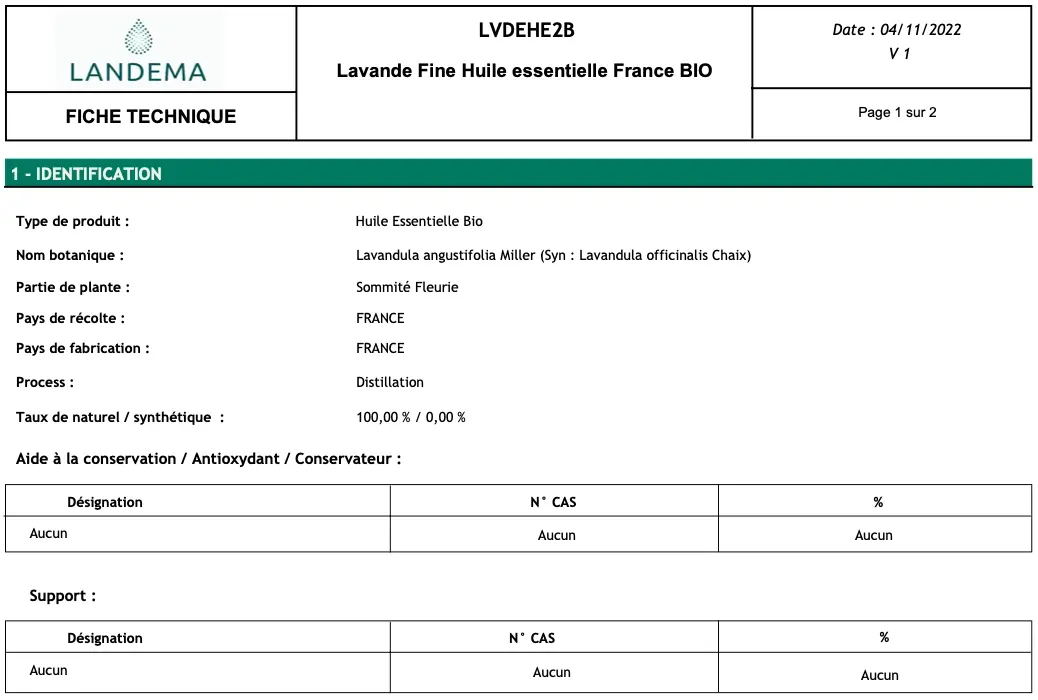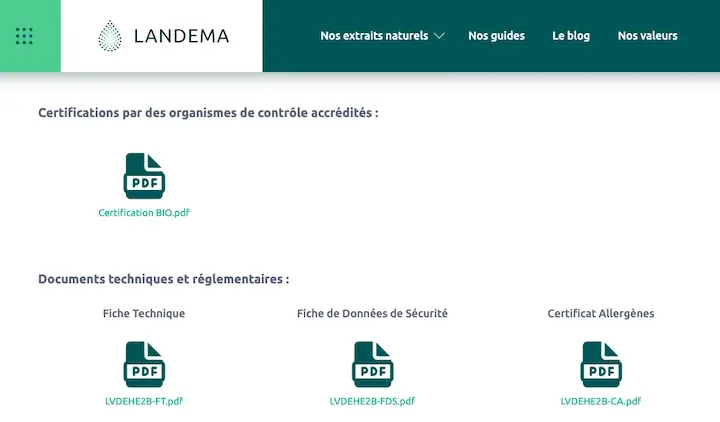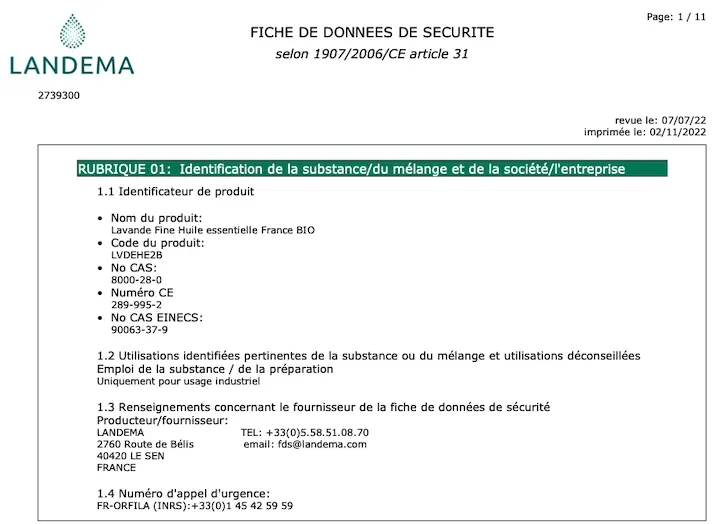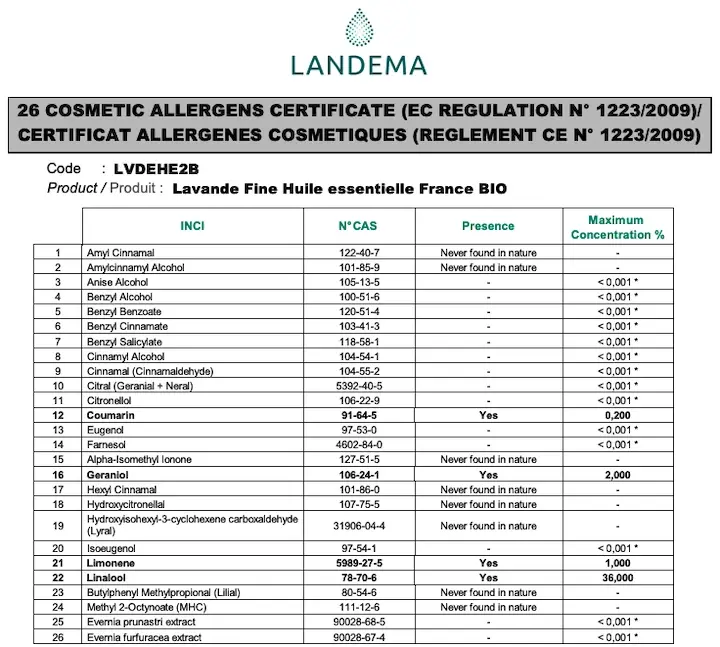SDS interpretation guide for professional formulators

April 02, 2024
Essential oils: decipher technical and safety data sheets like a pro
Essential oils are becoming increasingly popular and are used by professionals in many fields, including cosmetics, aromatherapy, perfumery and household cleaning. Behind those bottles, however, lie powerful, concentrated substances that must be used with care and full knowledge of the facts.
This is where Technical Data Sheets (TDS) and Safety Data Sheets (SDS) come in, two essential documents that accompany every essential oil. Understanding them is the key to enjoying all their benefits in complete safety. So, are you ready to decipher these sheets like a true expert? Landema.com, a specialist in the online sale of essential oils direct from the producer, is here to help: let's get started!
3 points to remember
The 3 main points to remember from the article you're about to read:
- The technical data sheet (FT) is essential for choosing and using an essential oil. It details its properties, recommended uses, composition and precautions for use. It's the ideal tool for selecting the right oil for your needs.
- The Safety Data Sheet (SDS) warns of the potential dangers associated with essential oils: flammability, toxicity, risks of irritation or allergy. It indicates the preventive and first-aid measures to be taken to ensure safe use.
- Deciphering these two types of information sheet is essential for any professional working with essential oils. This will enable them to master their use in complete safety, and ensure successful marketing and optimal risk management.

This sheet is an essential tool for choosing the right essential oil for your needs, and using it appropriately.
What is an essential oil data sheet?
A technical data sheet is a document that presents a specific essential oil in detail. It contains all the information you need to know about it and use it wisely.
It generally includes the following elements
Product identification
First of all, the data sheet clearly identifies the essential oil, giving :
- Botanical name and common name
- The part of the plant used (flowers, leaves, bark, etc.)
- Extraction process (distillation, cold expression, etc.)
It also specifies its appearance (color, consistency, characteristic odor).
Certifications and technical data
Next, the data sheet indicates whether the essential oil benefits from specific certifications, such as organic farming. It also provides precise technical data such as
- Density
- Refractive index
- Rotatory power
- Main biochemical composition
This information ensures the authenticity, purity and quality of the product.
Regulatory information
Finally, the technical data sheet includes regulatory information such as :
- CAS number (for Chemical Abstracts Service), assigned to each chemical substance, organic and inorganic, and included in the public TSCA (Toxic Substances Control Act) inventory of known chemical substances.
- The EINECS number, which identifies a chemical substance listed in the European Inventory of Existing Commercial Chemical Substances.
- The EC number, also used to identify a chemical substance, this time by the European Chemicals Agency under the REACH (Registration, Evaluation and Authorisation of Chemicals) regulation on the manufacture, placing on the market and use of chemicals.
These different numbers confirm compliance with the various chemical inventories.
- Authorized uses (food, cosmetics, etc.)
- For perfume and cosmetic use, the INCI names Cosing (Cosmetic ingredient Database) and PCPC (Personal Care Products Council) are given, to be used on the labels of products using essential oil as an ingredient.
The data sheet also gives advice on suitable packaging and optimal shelf life for essential oils.
For more information on this subject, please refer to Our advice on storing essential oils.
As you can see, the technical data sheet is a veritable concentrate of valuable information. It's the ideal tool not only for choosing the right essential oil for your needs, but also for using it safely and with full knowledge of the facts.

How do I find the technical data sheet for an essential oil?
Usually, the supplier makes available the technical data sheet corresponding to each essential oil reference, for download from their website.
On Landema.com, you can download it directly from the product sheet you're interested in, as long as you're logged in to your customer account. You'll find the regulatory documents shown as an example on the product sheet for Organic Lavender essential oil (Lavandula angustifolia).
To create your customer account, if you haven't already done so, go to https://landema.com/register
What's the difference between the technical data sheet and the certificate of analysis?
The technical data sheet is usually accompanied by a certificate of analysis (COA), which attests to the quality and conformity of the essential oil. The COA presents the results of physico-chemical and chromatographic analyses carried out on a specific batch.
At Landema.com, it is sent to you on request or after your order.
It includes a detailed chromatographic profile that identifies the oil's main compounds and their respective percentages. The COA thus confirms that the composition of the essential oil complies with current standards.
Other technical data, such as specific indexes, density and allergenic molecule content, can also be included on the certificate of analysis. This is an invaluable complement to the technical data sheet, to ensure the authenticity and impeccable quality of the product.
By cross-referencing the information on the technical data sheet and the certificate of analysis, you'll have a complete picture of the essential oil you've selected. Two essential tools for confident use!

What is a safety data sheet (SDS)?
Unlike a product data sheet, a safety data sheet (SDS) is a regulatory document that identifies the hazards associated with a chemical substance such as an essential oil.
Its purpose? To enable safe handling, use and transport, by providing information on potential risks and associated preventive measures.
The SDS is essential for transporting essential oils, particularly by air. In the event of an incident or accident, it also enables the emergency services to intervene appropriately, depending on the nature of the product (flammable, corrosive, toxic, etc.).
What does an SDS for an essential oil contain?
A safety data sheet is a comprehensive, standardized document with many detailed sections. Here are the most important ones for essential oils:
Hazard identification
This section uses standardized hazard pictograms to give a visual indication of the main risks: flammability, toxicity, environmental hazards, etc. It also lists the risk phrases to be applied to the product.
It also mentions the corresponding regulatory risk phrases according to the GHS (Globally Harmonised System of Classification and Labelling of Chemicals) classification.

For example :
- SGH02: Flammable liquids and vapors
- SGH05 : Corrosive, may cause skin or eye irritation
- SGH07: Causes severe eye irritation
- SGH08 : Toxic, may be fatal if swallowed or enters respiratory tract
You can find more details in our article on GHS classification.
The SDS lists the main hazards associated with essential oils, such as irritation, allergic sensitization and phototoxicity. It also identifies special risk groups such as pregnant women, children or asthmatics.
To find out more about which essential oils can be used by pregnant women, read our article Essential oils and pregnancy: your practical, reassuring guide.
Composition and information on ingredients
This section details the chemical composition of the essential oil, listing its main compounds (alcohols, phenols, ketones, aldehydes, etc.) and their respective concentrations, in descending order.
Some of these compounds, such as phenols, may present specific hazards which are mentioned.
First aid, fire-fighting and accidental release measures
These sections describe what to do and what first aid measures to take while awaiting medical attention in the event of an incident such as accidental ingestion, splashing in the eyes, fire or dispersion of the essential oil.
Handling, storage and exposure controls/personal protection
These sections provide precautions for safe handling and storage of the essential oil, including :
- Suitable storage conditions (temperature, light, containers, etc.); you can also refer to Our advice on storing essential oils for more information.
- Technical risk prevention measures (ventilation, explosion-proof equipment, etc.).
- Personal protective equipment (gloves, goggles, etc.)
Physico-chemical properties
The SDS provides information on properties such as the flash point, explosive limits, solubility and viscosity of essential oils. These data can be used to assess the risk of fire, explosion or undesirable chemical reactions.
Toxicological and ecological information
Finally, the data sheet summarizes the potential toxic effects on human health in the event of excessive exposure, whether acute or chronic. It also mentions environmental hazards in the event of accidental release into the environment.
As you can see, the SDS is packed with detailed information on the risks associated with the use of an essential oil. By carefully deciphering it, you'll be able to take all the necessary precautions for perfect safety.

You may notice that an Allergen Certificate can be added to the SDS. It specifies the presence or absence in the essential oil of the 26 allergens listed in European regulation EC 1223/2009, as well as their maximum concentration.
How to use the SDS for safe handling?
Here are a few essential tips for making the most of the information contained in the safety data sheet:
- Identify the main hazard pictograms at a glance.
- Locate the hazard statements (GHS phrases, etc.) relating to the essential oil.
- Carefully read the sections on first aid and handling.
- Strictly observe the recommended protective equipment and storage conditions.
- If in doubt, seek training or the advice of a qualified professional.
Landema.com's Customer Service is here to answer your questions, so don't hesitate to contact us.
Remember, prevention is the best protection. It's better to be cautious than to take ill-considered risks with substances as concentrated as essential oils.
Conclusion
Technical data sheets and SDSs are essential complementary documents for understanding and mastering essential oils. The data sheet provides information on the characteristics of the essential oil, while the SDS warns of potential hazards. Any professional using essential oils in his or her products needs to decipher them in depth for optimal marketing and risk management.



